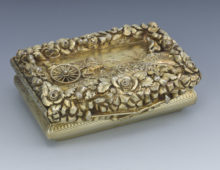Tagged with Industrial Revolution
Resource : Textile sample books
Cotton was one of the latest textile fibres to be introduced to Britain as a raw material within a manufacturing system, but between the eighteenth and nineteenth centuries it rose to prominence as a cornerstone of the British economy. Cotton manufacture stimulated industrialisation, global commercial influence, and new communities of labour. This is one of five early sample books illustrating the cotton and calico designs produced by the textile industry in Salford between 1769 and 1851.
Resource : Crompton’s spinning mule
The spinning mule was invented by Samuel Crompton in 1779. It revolutionised textile production by vastly increasing the amount of cotton that could be spun at any one time. But this also meant textile manufacturers no longer needed to pay individual spinners to create spindles (wooden rods) wound with cotton thread, as just one operator could now use the machine to spin hundreds of spindles at once.
Resource : Tipstaff used to arrest Dic Penderyn during the Merthyr Rising
This is part of a metal-tipped stick of the sort carried by constables in the 1800s. It was used in 1831 during the arrest of Dic Penderyn who was wrongly convicted and hanged for stabbing a soldier during the Merthyr Rising in South Wales.
Resource : Stephenson’s Rocket heads back up north to Manchester
June 13, 2018 - Richard Moss
Stephenson’s Rocket will return to Manchester for the first time in over 180 years in September 2018.
Resource : View of New Lanark by John Winning
Throughout the 1800s Britain became a busy industrial nation. People migrated in increasing numbers from the countryside to towns and cities to work in new factories and mills. Working conditions were poor and dangerous, injuries from machinery were common and workers – including children as young as six – worked long hours. Overcrowding, limited diets and polluted water led to widespread disease and early death. New Lanark, a village on the River Clyde near Glasgow, was a revolutionary industrial and housing complex, combining a cotton mill with purpose-built housing, education and social care for its workers and their families. The ideas put into practice here marked the beginning of cooperative socialism.
Resource : Davy lamp
The humble miner’s safety lamp is, arguably, one of the most important inventions of the 1800s. The industrial revolution saw coal overtake wood as the most important fuel source for new industries and cities, with an ever increasing demand driving production and placing pressure on safe and efficient extraction. A lamp that could light the way, without causing a disastrous explosion, was as essential a piece of a miner’s kit as a pick-axe.
Resource : Jacquard Loom
Before the 1800s, complex woven designs were created by hand. This was very labour-intensive. As a result, patterned fabric was extremely expensive. In 1804 Joseph-Marie Jacquard (1752 – 1834) developed the Jacquard Loom, which mechanised the production of patterned textiles. The loom contributed to the transformation of textile weaving from a ‘cottage industry’ run by close-knit families of skilled workers, to a focus of mass production on an industrial scale.
Resource : Boulton, Watt and Murdoch: ‘The Golden Boys of Birmingham’
This gilded bronze statue, known as the ‘Golden Boys’ (and also the ‘Carpet Salesmen’!) honours Matthew Boulton, James Watt and William Murdoch. They are shown studying steam engine plans. Together these three revolutionised the steam engine – the technology that would literally drive the industrial revolution.
Resource : The life and adventures of Michael Armstrong, the factory boy by Frances Trollope
This illustrated novel by Frances Trollope (1779-1863) was published in monthly parts in 1840, costing one shilling apiece. It tells a fictional story of Michael Armstrong, based on the real-life hardships, exploitation and suffering of children in the workplaces of the Industrial Revolution. It was the first novel about industrial life in Britain and made an important contribution to the campaign to reform conditions for workers – especially children.
Resource : British politics in the Age of Revolution
The continued calls for the reform of British politics and representation of marginalised sectors of society, and the establishment’s unprecedented measures to restrict and suppress these ‘radical’ ideas and demands.


